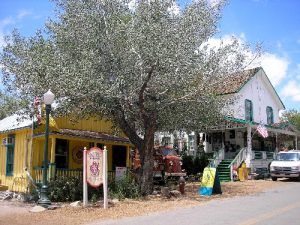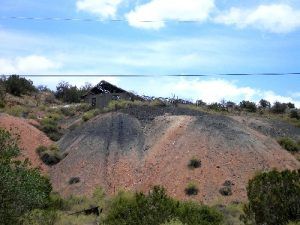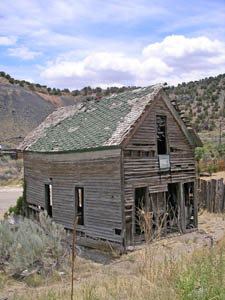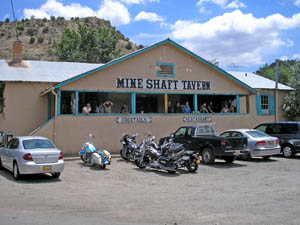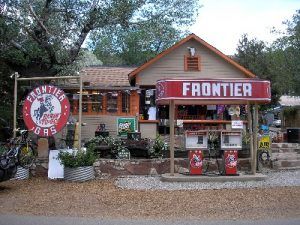Nestled on the northeast side of the Sandia Mountains is Madrid, New Mexico. Sitting midway along The Turquoise Trail National Scenic Byway, Madrid is categorized as a ghost town even though this small village of about 400 residents is bustling during the summer months with shops, restaurants, and galleries catering to the many visitors along this ancient path.
As many as 1,500 years ago, the first Native American inhabitants mined the turquoise and lead deposits in the nearby hills. When the Spaniards first arrived in 1540, they largely ignored the Indians and their turquoise, more interested in finding the more valuable minerals of silver and gold.
However, they returned almost a century later and, finding silver, forced the natives to work in the mines until the Pueblo Revolt of 1680. Thirteen years later, in 1693, the Spanish Crown re-conquered the area.
Spaniards continued to look for gold but also began to establish farms and ranches in the area. However, the region remained fairly unpopulated until large amounts of coal were discovered around 1835. Just five years later, placer gold deposits were discovered in the San Pedro Mountains, and the area that would become Madrid began to grow as more and more prospectors arrived in search of their fortunes.
The town of Madrid (pronounced with the accent on the first syllable: MAD-rid, not Ma-DRID) was founded in 1869, but it wasn’t until the 1880s when the Santa Fe Railroad arrived in the area that coal mining began on a large scale. By this time, the short-lived gold had played out, and most of the solitary miners gave way to larger companies who moved in to develop large coal mining operations.
By 1892 the yield from a narrow valley known as “Coal Gulch” was large enough to warrant the construction of a 6.5-mile spur from the Santa Fe Railroad.
The rich coal mines upon which Madrid sat covered some 30 square miles, connected by a network of tunnels that made up the Lucas & White Ash, the Peacock, and the Cooke mines. During this time, over 3,000 people lived and worked in Madrid, exceeding Albuquerque in population.
In 1906, all coal production in the area was consolidated at Madrid, with the Albuquerque and Cerrillos Coal Company creating a “company town” that supported about 3,000 people. Providing the residents with almost all of its needs, the company provided housing, brought in as much as 160,000 gallons of water daily in tank cars, and provided medical care for their employees.
In 1919, a man named Oscar Huber, who had worked for the company since 1910, was promoted by George Kaseman as Superintendent of Mines for the Albuquerque and Cerrillos Coal Company in Madrid.
Though many miners working during this time suffered hazardous working conditions with little sympathy from mine owners and managers, Huber was a different sort. Under his direction, Madrid residents enjoyed paved streets, a hospital, a company store, schools, and unlimited electricity from the company-owned power plant in their homes. During Prohibition, the company even furnished a place where people could distill illegal liquor. Of course, since the company controlled commerce, miners’ wages went right back to the owners’ pockets, but under Huber’s capable leadership, Madrid became a model for other mining towns to follow. He also formed the Employees’ Club, athletic activities, and town events.
Huber also built the first illuminated baseball park west of the Mississippi in 1922. The stadium was home to the Madrid Miners, a farm team for the Brooklyn Dodgers, who played a game in the park in 1934. The baseball park is still utilized today.
Coal production peaked in 1928 when over 180,000 tons were shipped out of Madrid on coal cars. In 1936, when the owner was killed in a mine accident, Huber gained a controlling interest in the mine and continued to operate a friendly working environment for the employees. In fact, when the Mineshaft Tavern burned to the ground on Christmas Day, 1944, he rebuilt it. In 1947, Huber purchased the town of Madrid and the surrounding coal lands.
But, the boom was not to last for Madrid. When natural gas began to be the more popular fuel for home heating, the demand for coal began to fall. The town of Madrid collapsed along with the coal market. In 1954, the Albuquerque and Cerrillos Coal Company ceased to operate, and almost all of its residents moved away. In fact, in that same year, an ad in the Wall Street Journal listed the entire town for sale for $250,000. However, there were no takers.
By the early 1970s, Oscar Huber’s son, Joe, by then, the owner of the entire townsite, began to rent or sell a few of the old company houses to a number of artists, craftsmen, and other individuals wanting to make their homes in the mountains. Determined to breathe new life into the town, he succeeded as more and more people moved into the area, and Madrid was reborn.
Today this unique and picturesque small town is a haven for day-trippers and travelers along the historic Turquoise Trail Scenic Byway, as they stop to browse its many shops, cafes, and bed & breakfast inns.
Inside the Mineshaft Tavern, a popular stop for motorcycle riders is the historic pine and oak bar from the original saloon and is still known as the “longest bar in the state.”
Madrid is best known for its annual Christmas lighting display, where virtually every building in the small town is decorated with an elaborate display of lights and nativity scenes. This tradition of beautiful lights began in the 1920s when the electric plant, owned by the town’s coal company, was providing free electricity to the many residents of the town. The miners were “required” to buy a tree for the lights, which is said to have cost about a weeks worth of pay, but since its inception, people from all over the area, including Albuquerque and Santa Fe, make the trip to Madrid to see this fascinating Christmas display.
Today, most of Madrid’s remains have been restored or preserved, including the Miner’s Amusement Hall, the old Catholic Church, the Coal Mining Museum, most of the storefronts, and many of the wooden company houses. However, on the outskirts of town, you will still some of these tumbling down buildings in their original state.
For those that are looking for a different kind of experience, Madrid and the entire surrounding area are said to be haunted. Numerous ghost sightings have been reported in homes, in the old church, in the cemetery, and the Mine Shaft Tavern. Often reported wandering the arroyos surrounding the town is the spirit of La Llorona. Though many believe that this ghostly Weeping Woman is nothing but a legend, many New Mexicans believe this tall, thin, natural beauty haunts many places in the Southwest.
One often reported sighting is that of a silent cowboy who has often been seen escorting a Spanish woman, dressed in her best finery, down Main Street. Others have allegedly seen and heard all types of ghostly forms in the cemetery.
But the most haunted of all places in Madrid is said to be the Mine Shaft Tavern. Though it burned down on Christmas Day, 1944, Madrid’s town father, Oscar Huber, rebuilt the tavern for the many coal miners of the area. It reopened in 1947 and has been open ever since. Some remodeling of the old saloon was completed in 1982; however, no changes were made to its historic bar — the longest bar in New Mexico. Today, this historic saloon continues to serve the many visitors along the Turquoise Trail.
Staff as well as guests have often seen glasses fall from their perches and crashing to the floor in bits and pieces. Doors are often seen opening with unseen hands and swinging back and forth. From the six-inch thick adobe walls, mysterious sounds are often heard and after closing hours, numerous objects and furnishings are moved about. However, the most unsettling reports are the stories told by staff of looking in the mirror, and instead of seeing their own reflections, they see a ghost.
Believe it or not.
Madrid is about 27 miles southwest of Santa Fe, New Mexico, on NM 14.
Contact Information:
Visit Madrid
PO Box 375
Madrid, New Mexico 87010
Novelist, screenwriter and audio producer Andrew Wice produced a Oral History Tour of Madrid. Check it out on his website.
© Kathy Weiser/Legends of America, updated April 2021.
Also See:
The Turquoise Trail Scenic Byway
Golden, New Mexico Has Seen Better Days

